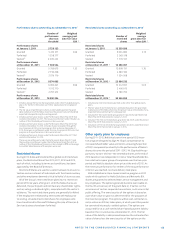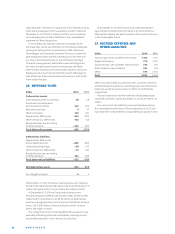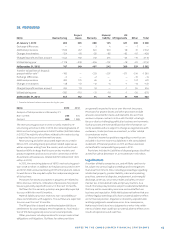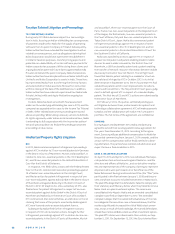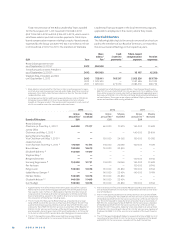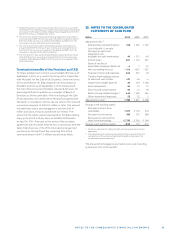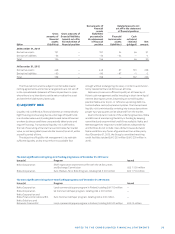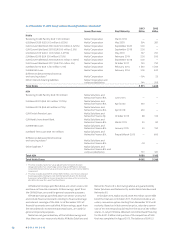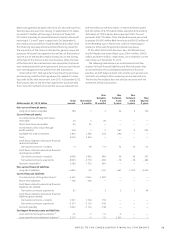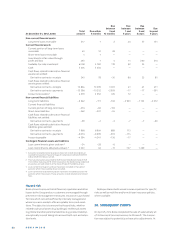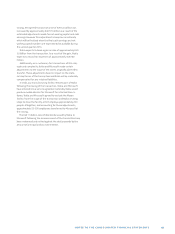Nokia 2013 Annual Report Download - page 75
Download and view the complete annual report
Please find page 75 of the 2013 Nokia annual report below. You can navigate through the pages in the report by either clicking on the pages listed below, or by using the keyword search tool below to find specific information within the annual report.73
NOTES TO THE CONSOLIDATED FINANCIAL STATEMENTS
is based on visibility of the key risks preventing Nokia from
reaching its business objectives rather than solely focusing on
eliminating risks.
The principles documented in the Nokia Risk Policy and
approved by the Audit Committee of the Board of Directors
require risk management and its elements to be integrated
into business processes. One of the main principles is that the
business or function head is also the risk owner, but it is eve-
ryone’s responsibility in Nokia to identify risks, which prevent
Nokia from reaching its objectives. Risk management covers
strategic, operational, fi nancial and hazard risks.
Key risks and opportunities are reviewed by the Nokia
Leadership team and the Board of Directors in order to create
visibility on business risks as well as to enable prioritization
of risk management activities at Nokia. In addition to the
general principles defi ned in the Nokia Risk Policy, specifi c risk
management implementation is refl ected in other key Nokia
policies.
The following information for has been presented
for Nokia continuing operations only. The comparative year
includes the Nokia Group total.
Financial risks
The objective for Treasury activities in Nokia is to guarantee
suffi cient funding for the Group at all times, and to iden-
tify, evaluate and manage fi nancial risks. Treasury activities
support this aim by mitigating the adverse eff ects caused by
fl uctuations in the fi nancial markets on the profi tability of the
underlying businesses and by managing the capital structure
of the Group by prudently balancing the levels of liquid assets
and fi nancial borrowings.
Treasury activities are governed by the Treasury Policy ap-
proved by the CEO, that provides principles for overall fi nancial
risk management and determines the allocation of responsi-
bilities for fi nancial risk management in Nokia. Other related
policies and procedures in Nokia and NSN, approved by respec-
tive CFO’s or relevant fi nance executives, cover specifi c areas
such as foreign exchange risk, interest rate risk, credit and
liquidity risk as well as use of derivative fi nancial instruments
in managing these risks. Nokia is risk averse in its Treasury
activities.
Financial risks are divided into (a) market risk (covering for-
eign exchange risk, interest risk and equity price risk), (b) credit
risk (covering business related credit risk and fi nancial credit
risk) and (c) liquidity risk.
A) MARKET RISK
Methodology for assessing market risk
exposures: Value-at-Risk
Nokia uses the Value-at-Risk (“VaR”) methodology to assess
the Group exposures to foreign exchange, interest rate, and
equity risks. The VaR gives estimates of potential fair value
losses in market risk sensitive instruments as a result of
adverse changes in specifi ed market factors, at a specifi ed
confi dence level over a defi ned holding period.
In Nokia, the foreign exchange VaR is calculated with the
Monte Carlo method which simulates random values for
exchange rates in which the Group has exposures and takes
the non-linear price function of certain foreign exchange
derivative instruments into account. The variance-covariance
methodology is used to assess and measure the interest rate
risk and equity price risk.
The VaR is determined by using volatilities and correlations
of rates and prices estimated from a one-year sample of
historical market data, at % confi dence level, using a one-
month holding period. To put more weight on recent market
conditions, an exponentially weighted moving average is
performed on the data with an appropriate decay factor.
This model implies that within a one-month period, the
potential loss will not exceed the VaR estimate in % of pos-
sible outcomes. In the remaining % of possible outcomes, the
potential loss will be at minimum equal to the VaR fi gure, and
on average substantially higher.
The VaR methodology relies on a number of assumptions,
such as a) risks are measured under average market conditions,
assuming that market risk factors follow normal distributions;
b) future movements in market risk factors follow estimated
historical movements; and c) the assessed exposures do not
change during the holding period. Thus it is possible that,
for any given month, the potential losses at % confi dence
level are diff erent and could be substantially higher than the
estimated VaR.
Foreign exchange risk
Nokia operates globally and is exposed to transactional and
translational foreign exchange risks. Transaction risk arises
from foreign currency denominated assets and liabilities
together with foreign currency denominated future cash fl ows.
Transaction exposures are managed in the context of various
functional currencies of foreign Group companies.
According to the foreign exchange policy guidelines of the
Group, which remains the same as in the previous year, mate-
rial transactional foreign exchange exposures are hedged
unless hedging would be uneconomical due to market liquidity
and/or hedging cost. Exposures are defi ned using nominal
values of the transactions. Exposures are mainly hedged with
derivative fi nancial instruments such as forward foreign ex-
change contracts and foreign exchange options. The majority
of fi nancial instruments hedging foreign exchange risk have a
duration of less than a year. The Group does not hedge fore-
cast foreign currency cash fl ows beyond two years.
Since Nokia has subsidiaries outside the euro zone, transla-
tion risk arises from the euro-denominated value of the share-
holders’ equity of foreign Group companies being exposed to
fl uctuations in exchange rates. Equity changes resulting from
movements in foreign exchange rates are shown as a transla-
tion diff erence in the Group consolidation.
Nokia uses, from time to time, forward foreign exchange
contracts, foreign exchange options and foreign currency
denominated loans to hedge its equity exposure arising from
foreign net investments.
At the end of years and , the following curren-
cies represent a signifi cant portion of the currency mix in the
outstanding fi nancial instruments:


